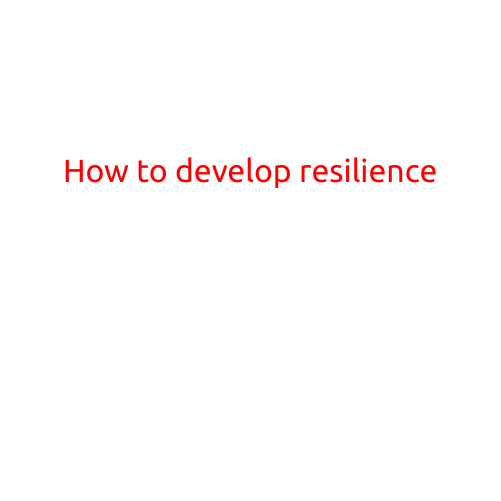
How to Develop Resilience: Building Strength in the Face of Adversity
Resilience is the ability to withstand and recover from difficult situations, and it’s a valuable asset in both personal and professional life. Developing resilience can help you navigate challenges with greater ease, build stronger relationships, and achieve your goals despite obstacles. In this article, we’ll explore the key principles and strategies for building resilience.
Understanding Resilience
Resilience is not a fixed trait, but rather a skill that can be developed over time. It’s the ability to adapt to changing circumstances, manage stress and adversity, and bounce back from setbacks. People who are resilient tend to have a optimistic outlook, a sense of control, and a strong support network.
Building Resilience
Developing resilience requires a combination of self-awareness, self-care, and coping strategies. Here are some practical tips to get you started:
- Practice Positive Self-Talk: The words you use to talk to yourself can either build or break your confidence. Focus on positive affirmations, and reframe negative self-talk to boost your self-esteem.
- Learn Relaxation Techniques: Stress and anxiety can erode resilience. Practice relaxation techniques such as meditation, deep breathing, or yoga to calm your mind and body.
- Develop a Growth Mindset: Instead of viewing failures as setbacks, see them as opportunities to learn and grow. Focus on building your strengths and improving your weaknesses.
- Build a Support Network: Surround yourself with people who encourage and support you. Build strong relationships with friends, family, and colleagues.
- Take Care of Your Physical Health: Regular exercise, healthy eating, and sufficient sleep are essential for maintaining physical and mental well-being.
- Practice Gratitude: Focus on the positive aspects of your life and express gratitude for what you have.
- Embrace Change: Change is inevitable, and embracing it can help you build resilience. Focus on the opportunities that come with change, rather than resisting it.
- Develop Problem-Solving Skills: Break down complex problems into manageable tasks, and focus on finding solutions rather than getting bogged down by the problem itself.
- Learn from Failure: View failure as a stepping stone to success. Learn from your mistakes, and use them as opportunities to grow and improve.
- Practice Mindfulness: Stay present in the moment, and focus on what you can control. Mindfulness can help you avoid getting overwhelmed by stress and anxiety.
Real-Life Examples of Resilience
While it’s easy to learn about resilience in theory, it’s more powerful to see it in action. Here are a few real-life examples of people who have demonstrated remarkable resilience:
- J.K. Rowling: The author of the Harry Potter series struggled with poverty and depression after the death of her mother. However, she persevered and went on to become one of the most successful authors in the world.
- Stephen Hawking: Diagnosed with a motor neuron disease at the age of 21, Hawking defied the odds and lived for more than 50 years with his condition. He continued to work and make groundbreaking contributions to physics despite his disability.
- Malala Yousafzai: Shot by the Taliban for speaking out against their efforts to ban girls’ education, Malala has become a global advocate for girls’ education. Despite the attempt on her life, she continues to fight for her cause.
Conclusion
Developing resilience is a journey that requires effort, patience, and persistence. By incorporating the strategies outlined in this article into your daily life, you can build a stronger, more resilient self. Remember to be kind to yourself, focus on the present, and view challenges as opportunities for growth and learning. With time and practice, you too can become a more resilient and stronger person.





